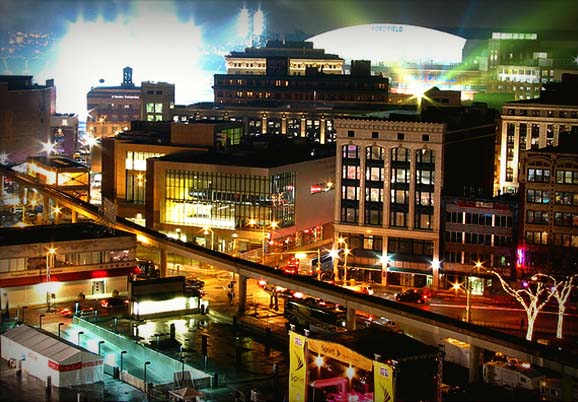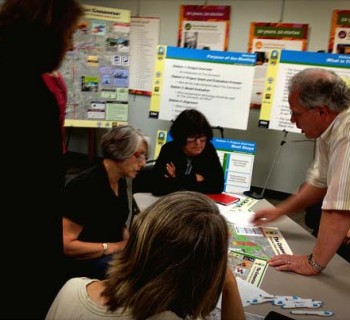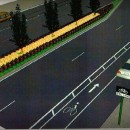Editor's Note: This article was originally posted on Sustainable Citites Collective's website, and is reposted with permission.
Outsiders, not locals, revitalized New Orleans. Rich or poor, long-term residents can’t see the diamonds in the rough. Hurricane Katrina washed out the parochial thinking that was killing Big Easy. Lessons for Detroit:
“After a tragedy is one of the few times you can be trying to reimagine a city rather than just trying to go back to what you were before,” said Scott Cowen, the president of Tulane University, who is writing a book examining the remaking of New Orleans after the devastation of Hurricane Katrina in 2005. “What you really need is transformational change, not just incremental change to get back to where you were,” he said in an interview. “That’s been very important to resurgence of this city, and Detroit has to do the same thing.”
If Detroit really does need transformational change, then current residents and institutions are incapable of providing it. Old school Detroit is fodder for ruin porn. Outsiders, carpetbaggers, find opportunities where the firmly entrenched acknowledge failure. A broken place suggests a former state of working. Vagabonds have no idea what that looked like. The double-edged sword of the hipster invasion:
“Katrina did two things,” says Tim Williamson, the CEO of Idea Village, which recently sponsored New Orleans Entrepreneurship Week (NOEW). “Everyone became an entrepreneur because everyone was starting over in some way—we became a start-up city.” Second, he says, “our networks scaled globally.” Williamson and four fellow entrepreneurs founded Idea Village, a not-for-profit organization, in 2000 in order to identify and support local entrepreneurs. But it wasn’t until after Katrina—when the city’s plight triggered a huge influx of people who wanted to help rebuild—that the organization gained real traction. Among those who showed up were MBA students from top business schools who opted to spend spring break rolling up their sleeves to help New Orleans entrepreneurs rather than hitting the beaches. One of those MBAs was Daryn Dodson from Stanford; the following year, he returned with 25 fellow Stanford MBAs, who were supported by alum Jim Coulter, co-founder of Silicon Valley private equity giant, TPG. “Stanford would not have come here if it weren’t for Katrina,” says Williamson. He and his partners saw that the time was right for New Orleans to attract world-class resources in order to nurture its homegrown entrepreneurial talent.
That’s how New Orleans got on the hipster map, for better or for worse. The invasion indicates a community’s networks scaling globally. On the backs of these migrants come fresh ideas and knowledge, density be damned. New Orleans was re-imagined and experienced transformational change. The same could happen to Detroit and, South Korea:
Dr. Emanuel Pastreich, a long-time resident of Korea who has worked with various Korean academic and government institutions in efforts to increase Korea’s global stature, has recently released a remarkable book that presents the quintessence of his philosophy. Dr. Pastreich is the director of the Asia Institute and a professor at Kyung Hee University, and has penned A Different Republic of Korea about Which Only Koreans Are Ignorant, which has drawn considerable attention. …
… The book is meant as a touchstone to point Korea in the right direction towards its true long-term potential on the global stage. Much of the focus falls on the various hidden treasures in Korean culture itself. Pastreich uses a powerful parable taken from the Lotus Sutra to describe Korea’s relationship with its own culture.
The parable goes like this. A man meets an old friend and they talk until late in the evening. Before dawn, the friend leaves while the man is still asleep. The friend takes a priceless gem and sews it into the lining of the man’s jacket as a special gift to help him, and then he leaves before the man awakes. When the man wakes up he continues on his travels, unaware of the jewel sewn into his clothes. He suffers painful experiences, being subjected to hunger, disease, and terrible poverty. After many years, he meets up again with his friend who tells him that he had had a priceless jewel in his clothes all that time, but had been unaware of it. The point of the parable is that often the most valuable things in our lives we have right with us, but we are completely unaware of their presence. In the case of Korea, there is a profound lack of awareness of the richness of Korean culture itself.
Like Korea, the Rust Belt I know experiences a profound lack of awareness of its own cultural richness. Thus, the rushing in of Rust Belt Chic to fill that void. Repatriates and newcomers find charm where others lament what used to be there. Despite what Robert Putnam claims, the pre-Rust Belt days weren’t all that. Detroit fell far from grace? The city was a hole that everyone wanted to escape.
The rooted hold tightly to the past and the power. Detroit is a city of insiders. Chicago is one of outsiders. Saskia Sassen compares the two:
If it is not the product with its diverse components, what is it that happened in Detroit? The weak point was that all the diversity of components were mostly manufactured via subcontracts from the corporate car companies. The latter dominated and dictated. This made Detroit more akin to a plantation economy, no matter how complex a coffee bean it produced.
Chicago, in contrast, had multiple organizing logics. It was, in some sense, more networked, as we might say today. The knowledge embedded in those very diverse industrial sectors was eventually extracted and transformed/commodified into specialized servicing capabilities. It took work to dislodge that knowledge from certain types of organizational logic (heavy manufacturing, industrial agriculture, and continental level transport logistics) and insert it into a different type of organizational logic: that of today’s so-called knowledge economy.
Chicago’s political machine isn’t a paragon of open networking. I also think Sassen overemphasizes the region’s economic diversity. Quite simply, she overlooks the very talent migration that informed her line of inquiry:
When I arrived at the University of Chicago in the Fall of 1998, the mood downtown was that of a sense of loss –corporations and banks were leaving, and the general sense was that Chicago’s past as a heavy manufacturing center was to blame. But in fact, once one left the corporate heights it was clear that there was a lively economic and cultural scene of small enterprises, networked economies, old lofts transformed into beautiful restaurants catering to a whole new type of high-income worker—hip, excited, alive. Yes, there was a new vibrant economy of small specialized firms, software developers and experimental cultural spaces. The center of the city was gaining population even as the city at large was losing population (the best source for readable data on the population and economy of the city, is Chicago Crain’s long-term contributor.
Upon reading that, I know I have a new research project. Gentrification is where it—globalization—all starts. Birthplace diversity, not firm diversity, explains the divergent paths of Detroit and Chicago. The “new type of high-income worker” must come from someplace else. Otherwise inbreeding homophily rules. Too much social capital strangles innovation. Closed off to the outside, a small circle fights over a shrinking pie. Welcome to South Side, Chicago, or Gary, Indiana. Welcome to South Korea. Hello, Detroit.










